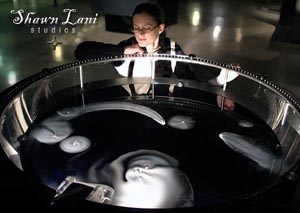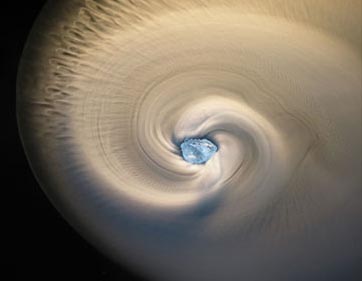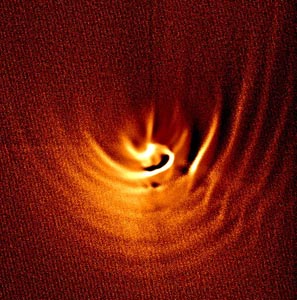
Icy Bodies
Introduction
Icy Bodies is the name of an exhibit at the Exploratorium created by Shawn Lani. In the exhibit, small pieces of dry ice (solid carbon dioxide) skitter across the surface of a pool of water, their paths marked by clouds. The patterns created by these particles are reminiscent of patterns observed in the tails of comets.
Materials
• A bowl of warm water, at least 25 cm in diameter and at least 1 cm deep (a dark bowl will provide the best contrast)
• Dry ice particles, less than 0.5 cm in diameter (wrap larger chunks of dry ice in a towel and break them with a mallet)
• Gloves or tongs for handling dry ice
Caution: do not touch the dry ice with your bare hands because frostbite can result after just a few seconds of contact. (Ask me how I know this.)
To Do and Notice
Place some pieces of dry ice in the bowl of water and notice the following phenomena:
• Large pieces will sink, but small pieces "float" on the surface of the water.
• White clouds appear around the floating particles.
• White jets of gas emitted by the particles propel the particles across the surface of the water.
• The jets cause the particles to spin.
• When two particles happen to be close together, they appear to attract each other. (What do you think causes the attraction?)
• When two particles touch, they stick together.
• Particles are reflected from the edges of the bowl.
What's Going On?
Large pieces of dry ice would sink because the density of dry ice is 1.5g/mL, greater than the density of water. The small particles appear to float, but they are actually supported by the surface tension of the water. Each particle rests in a smooth depression in the surface of the water created by the gas that sublimes from the particle. If you blow away the clouds near a particle, you can observe this depression in the water's surface.
Clouds form around the particles as water droplets condense out of the surrounding air. In addition, the carbon dioxide sublimes and creates jets of gas that look like fast-moving clouds. Unless these jets of gas are directed through the center of mass of the particle, they cause the particle to spin. If the particle is spinning as these jets are emitted, the trails wrap up into spirals.
The clouds ejected from two adjacent particles do not mix. Clouds from nearby particles are often separated from each other by a thin dark line. This shows how difficult it is to mix air masses.

A particle seems to be attracted to another when it falls into the depression in the surface of the water created by the first particle. The two particles join together at the bottom of this depression. I call this the "valley bed" phenomenon.
When particles travel to the edge of the bowl, they collide with the meniscus, a rim of water that rises up the sides of the bowl. The particles ride up the slope and fall back down, then reflect from the edge of the bowl.
So What?
As the nucleus of a comet rotates, ice-rich portions of the comet's surface are exposed to sunlight. These places sublime and shoot out jets of gas and dust that spread out in spiral patterns. The spirals look similar to those made by spinning pieces of dry ice.

Going Further
Charge up a PVC rod by rubbing it with wool. Hold it near a stationary piece of dry ice on the surface of the water, and notice that the dry ice is repelled by the electrically charged rod. What's going on here?
Aluminum coins also can be floated on the surface of water using surface tension. It's easiest to float a coin by lowering it onto the water using a plastic fork. Because the coins do not outgas and condense clouds, it's easier to observe the depression they make in the surface of the water. Viewed from the side, the coins will be seen to be completely below the surface of the surrounding water. It's also easier to explore the attraction of the coins to each other, and the repulsion of the coins by an electrically charged rod than it is the pieces of dry ice.
|
Scientific Explorations with Paul Doherty |
|
26 January 2006 |